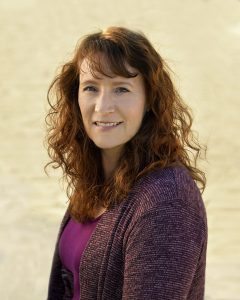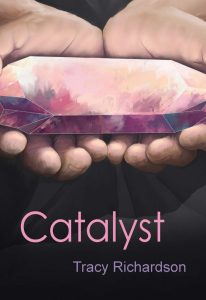Writing About the Environment for Teens
By Tracy Richardson, author of The Field (April, 2019), Catalyst (June, 2020) and Indian Summer (Sept., 2020)
 I’m a science geek. Everything about the natural world engages and amazes me. From observing a snail inching a slick path on a rotten stump during one of my hikes, to contemplating the vastness of the unknowable Universe, I find it all captivating. I have a degree in Biology and while I didn’t follow that path in my career choice, I use my science background in my science fiction writing and focus on environmental issues.
I’m a science geek. Everything about the natural world engages and amazes me. From observing a snail inching a slick path on a rotten stump during one of my hikes, to contemplating the vastness of the unknowable Universe, I find it all captivating. I have a degree in Biology and while I didn’t follow that path in my career choice, I use my science background in my science fiction writing and focus on environmental issues.
Each of my books focuses on a different environmental theme. In The Field the focus is on coal versus wind and solar and other renewable energies. Catalyst is about the dangers of fracking and Indian Summer is about trying to save an old-growth forest from development. But the books are more than simply a commentary on environmental issues. They are stories. The characters are engaged in an adventure that challenges them and causes them to grow and stretch themselves to meet those challenges. The vehicle of story is a great teacher. Fiction isn’t real, but it is true.
Fiction is a safe place to confront the difficult issues that teens deal with every day. Many teens are deeply concerned about the world they will inherit with soaring deficits and environmental issues. In The Catalysts series, the characters are actively involved in solving these problems. They are catalysts for change. I hope to inspire my readers that they, too can have an impact. That they have some agency, some control over their own futures. If they see a character dealing with difficult issues and then moving beyond them and finding solutions, you create hope.
My books are science fiction based in the real world experiences of my characters in present time. I like to explore ideas of what is really out there in the Universe around us. In The Field, Eric connects to the Universal Energy Field with his thoughts. He has premonitions that scare him because he doesn’t know what they mean or if they’re real. The idea that our thoughts have power and that we can connect to one another with our thoughts intrigues me. And I find that everyone has experienced it to a degree. When I talk with my readers, they all have a story about a premonition that came true or when some weird synchronicity happened that they can’t explain logically.
The Field also explores the idea that the Universal Energy Field all around us can be used as an unlimited source of clean renewable energy. Is this science fiction? Some scientists are actively exploring the concept. Could it be true?
In Catalyst I explore the idea that we are connected to the Earth and that what humans do has an impact on the Earth and its resources. Marcie and her friends are actively involved in trying to stop fracking activity in southern Indiana. They are helped by two mysterious graduate assistants on the archaeological dig. Zeke and Lorraine have abilities to access the Universal Energy Field and communicate telepathically. They provide hints to the idea that we are not alone in the Universe and that what happens on Earth will impact the Milky Way Galaxy and beyond. Could this be true? It’s an idea I find fascinating.
Development of an old growth forest is the theme in Indian Summer. I did a lot of research into how trees communicate with one another through their root systems, fungi and with their leaves and excreted scents. I find all this science so interesting!! And my readers tell me that they are intrigued as well. Are trees sentient beings? Is the Collective Consciousness in all living things? Such a cool idea!
Marcie and Eric and their friends are ordinary kids having extra-ordinary experiences. They have romances and homework. Friend issues and self-doubt. I hope that my readers can identify with my characters and see how they, too, can be catalysts for change.
—
TRACY RICHARDSON wasn’t always a writer, but she was always a reader. Her favorite book growing up was A Wrinkle in Time by Madeleine L’Engle. In a weird way that book has even shaped her life through odd synchronicities. She has a degree in biology like Mrs. Murry, and, without realizing it, she named her children Alex and Katie after Meg’s parents. Tracy uses her science background in her writing through her emphasis on environmental issues, metaphysics, and science fiction.
Tracy’s upcoming novel, “Catalyst” (Brown Books Publishing, June 2, 2020) is the second installment in the Catalysts series. To learn more about Tracy’s life and work, visit: https://
CATALYST
 Marcie Horton has a sixth sense. Not in the “I see dead people” way, but . . . well, maybe a little. She feels a sort of knowing about certain things that can’t be explained-an intuition that goes beyond the normal. Then there was that one summer four years ago, when she connected with a long-departed spirit . . . But nothing that incredible has happened to Marcie since.
Marcie Horton has a sixth sense. Not in the “I see dead people” way, but . . . well, maybe a little. She feels a sort of knowing about certain things that can’t be explained-an intuition that goes beyond the normal. Then there was that one summer four years ago, when she connected with a long-departed spirit . . . But nothing that incredible has happened to Marcie since.
This summer, Marcie is spending time working at Angel Mounds, the archeological dig her mother heads, along with her brother, Eric, and his girlfriend, Renee. The dig is the site of an ancient indigenous civilization, and things immediately shift into the paranormal when Marcie and her teammates meet Lorraine and Zeke. The two mysterious dig assistants reveal their abilities to access the Universal Energy Field with their minds-something Marcie knows only vaguely that her brother has also had experience with. Marcie learns how our planet will disintegrate if action is not taken, and she and her team must decide if they are brave enough to help Lorraine and Zeke in their plan to save Mother Earth, her resources, and her history. It looks like the summer just got a lot more interesting.
Category: On Writing























